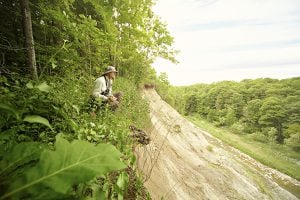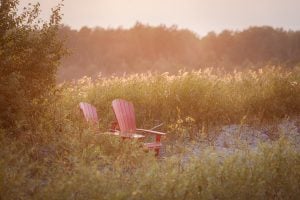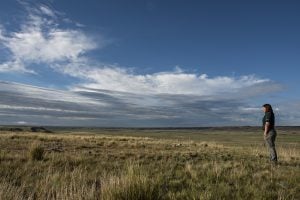Gordon Hempton dropped out of grad school to collect audio recordings of natural sounds. (Photo: Nayan Sthankiya)
After our dawn recording session, Hempton and I head back to Val Marie for breakfast at the village’s namesake hotel, in a wood-panelled, shag-carpeted tavern with a sign on the wall that says “If heaven doesn’t have horses, I’m not going” and a rail out front for tying up your steed. A compact grid of dusty streets bookended by a pair of grain elevators, Val Marie boasts the arena where Islanders star Bryan Trottier played as a kid and serves as the gateway to the national park’s more accessible West Block. About 140 people live here; the sign in front of the school congratulates every member of the 2011 graduating class: Jessica and Chantal. The population can double in the summer, however, as seasonal staff from Parks Canada (the community’s biggest employer) and visiting researchers flock to Val Marie.
Over bacon and eggs and bottomless cups of bitter coffee, Hempton and I talk about the prospect of some sort of quiet-place designation with Grasslands superintendent Katherine Patterson, species-at-risk biologist Pat Fargey, public relations communications officer Karin Smith Fargey and Rogier Gruys, a product development specialist from Jasper National Park. “Many people have come to the park and said it’s a gateway to times past,” says Patterson, officially the superintendent of Parks Canada’s South Saskatchewan Field Unit, which includes Grasslands. “You could go back 1,000 years and experience the same set of sounds.”
Parks Canada and Tourism Saskatchewan have funded Hempton’s trip to the park. He’s here, essentially, to determine just how quiet Grasslands is — to conduct a pilot sound survey, the first of its kind in a Canadian national park, and discover what we can hear (prairie dogs, a breeze sifting through fields of wheat grass, bison, birds) and what we can’t (us). The resulting recordings and analysis will help the park’s scientists better understand this terrain and its inhabitants and provide a soundtrack for interpretive materials that would increase awareness of the park’s unique soundscapes. (In late 2011, after analyzing his recordings and data, Hempton concluded that Grasslands is “the world’s pre-eminent North American prairie for quality of acoustic environment. No other North American prairie has exceeded its attributes of sound diversity and length of noise-free interval.”)
Today’s fieldwork is part of a week of reconnaissance for Hempton, who will do a second week of intensive recording, solo camping in the backcountry. For now, he wants to get a feel for a cross-section of spots inside the park at dawn, when the winds are calmest. “Listening is not so much about sound as it is about space and place,” he says. “My work is location, location, location.”
After breakfast, we hop into a truck with Pat Fargey, who takes us on a tour of the West Block. As we bounce along a double-track dirt road, Fargey tells us there are more than 60 different types of grass in Grasslands, among 400 or so plant species. Pulling to a stop on a promontory with a panoramic view over the Frenchman River valley, he starts listing all the grasses he sees: western wheat grass, blue grama grass, June grass, northern wheat grass. Hempton takes out his decibel meter and measures 23 dBA, a level that spikes to 61 when a small fixed-wing aircraft, barely visible between the clouds, passes overhead. It’s the first airplane we’ve seen in two days.
Gruys, whose own park is starting to consider the impact of noise (see Natural noise: How Jasper National Park is setting standards for preserving quiet), asks how the airplane might affect animals. Hempton uses a very human analogy. Animals can be particulary sensitive during mating season, he says, and it takes only one or two knocks on your bedroom door to make you fear that your privacy will be interrupted again.
We walk across a grassy plateau spiked with the pale pink petals of gumbo evening primrose. Hempton is carrying “Fritz,” a binaural microphone shaped like a human head that captures sound through the holes in its plastic ears. Using a grey-green sage bush as a windbreak, he places Fritz at ground level beside a clump of grasses. When Hempton records in the rain forest, he’s drawn to the strata of sound — the wind through the canopy, water droplets trickling down towering tree trunks, rodents scurrying in the underbrush. Here, it’s the same, only condensed. In the headphones, I hear bees buzzing around the flowering heads of grasses, mosquitoes droning around the stalks and insects crawling through the ground cover. Plus the wind, which not only rustles the ridgetop grasses but carries with it the calls of a Sprague’s pipit, a long-billed curlew and a pair of common nighthawks. “On one track,” announces Fargey, “you just got three species that are in trouble.”
The next morning at dawn, we drive nearly two hours in a misty drizzle to the park’s East Block to meet Geoff Delves. The West Block is defined by the Frenchman River valley; the East, home to some of Canada’s richest dinosaur beds, is dominated by badlands and exposed hillsides, a window into geologic time. Delves, a Parks Canada resource management/public safety specialist (née “warden”), is stationed in an isolated ranch house in the southeast corner of the East Block, within sight of the U.S. border. There’s a heavy-rainfall warning today, he says. A storm cell is headed this way from Montana, and up to five centimetres could fall. (Grasslands gets 30 to 33 centimetres of precipitation in an average year, about a third of that as snow. June 2011 will turn out to the one of the wettest months on record in southern Saskatchewan, with flood waters washing out bridges and soaking farm fields.)
Living alone in such a secluded place, Delves is intrigued by the notion of preserving natural quiet. But like many others, he wonders about the feasibility of changing ranching and farming practices (i.e., branding cows and driving tractors), about the construction of roads and visitor facilities, about the possibility of nearby oil and gas development and the long shot of legislative change. Still, he’s game for an adventure. We climb into his four-wheel-drive truck and splash along the waterlogged road behind his house, bouncing and side-sliding our way west, through muddy ruts, to the rim of the badlands.
Hempton does a few short test recordings at the precipice, protected from the wind and increasingly heavy rain by a stand of Manitoba maple, ash and willow trees. “These maple leaves haven’t been out long,” he says, fingering a soft green leaf. “They sound fresh.” The wind through these leaves, he explains, makes a soft subtle whisper in the spring. As the summer progresses, they crisp up and rustle. Come autumn, when the leaves are gone, the bare branches roar.
The wind and rain are now roaring, so we retreat to Delves’ home and attempt to wait out the storm in his garage, then his barn and, later, around his kitchen table with a couple pots of coffee. Whether indoors or outside, Hempton is constantly studying the sky, often with his eyes closed, always listening. “I love the drama and suspense of the weather,” he says. “Listening is all about letting go of the outcome. Storms remind us that as much as we think we’re in control, we’re not.”
To ward off cabin fever, I put on my head-to-toe rain gear and take a short walk, in what is now a deluge, to an opensided shed.
“Pop quiz,” says Hempton when I get back. “What did it sound like?”
“Wind,” I shrug.
“You failed.”
Hempton doesn’t wear waterproof clothing when he works — it’s too noisy — but I have no such restrictions. I set out again, this time on a long hike into the coulees, slipping down muddy deer trails until I reach a narrow cleft in the land. I find a sheltered overhang; a stream of water tumbles from its rocky lip to the drenched grass below. I pull out my own tiny digital recorder and get a few seconds of audio, preparing for my next test. Even through a tiny speaker, my recording sounds like a riffling river: a torrent strong enough to carve canyons or flood fields, a flow that hints at the undeniable force and grace of nature.
That night, I unfurl my sleeping bag on a bed of hay bales in the barn and fall asleep listening to wind and rain, dreaming of the ocean in the middle of the prairie.
We’re up again before 4 a.m. The rain has stopped, so Hempton and I climb into an ATV driven by Delves, and we slosh back to our cliffside perch, then descend the steep slope on foot through a tangle of waist-high juniper. The wha-whom, wha-whom of a mourning dove signals the sun’s imminent rise. Hempton finds a listening spot halfway down the coulee, in a stand of maple and ash, but the recording deck in his backpack is dead. Today’s trek will be another reconnaissance mission, it seems. We continue downward through patches of fragrant pasture sage and stunted greasewood. Delves has never seen this land so green. A golden eagle takes off as we enter a hollow, and Delves points out a pair of twin buttes in the distance. “That’s a big hunk of mud right there,” he says.
Hempton, fiddling with his recording deck, suddenly chimes, “We’re back in business. Magic.”
We climb a flat grass-topped rise and look at the buttes across a gloriously green valley. The sun is now up, the sky blue and empty of all but clouds and birds. Hempton hits record, attempting to capture 15 all-natural daytime minutes of grassland for the first time. All we hear is the wind and the occasional bird call, until, at 14 minutes and 20 seconds, a low rumble echoes across the coulee.
“Can you believe it?” says Hempton. “The first jet!”
He waits a few minutes, then tries again. I lie back on the grass, sun on my face, and fall asleep, lost in the wind, as the Sound Tracker records 22 minutes of a world without us.








